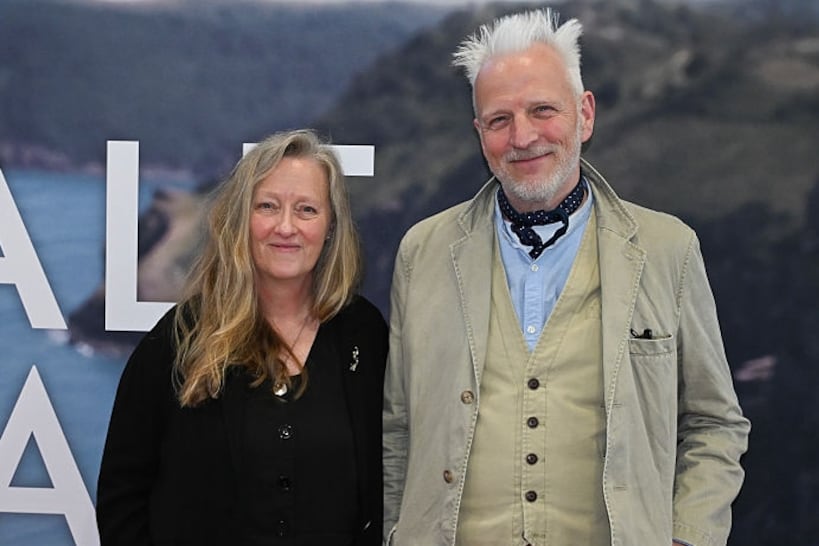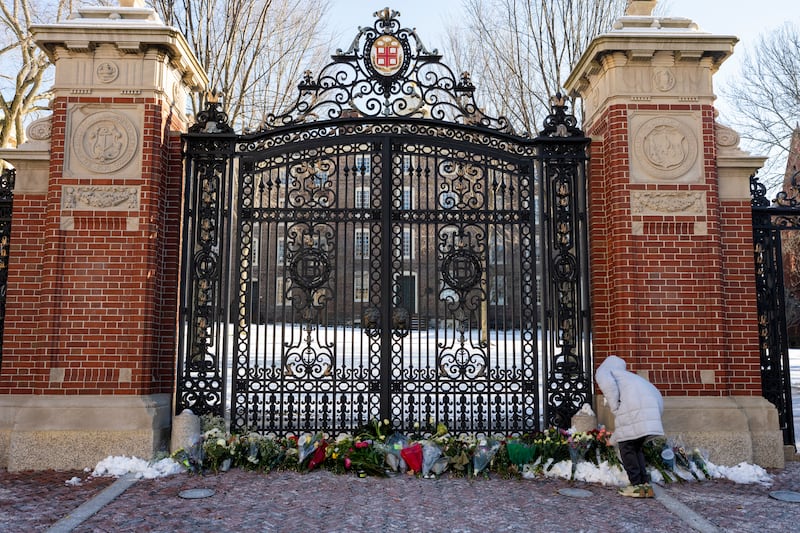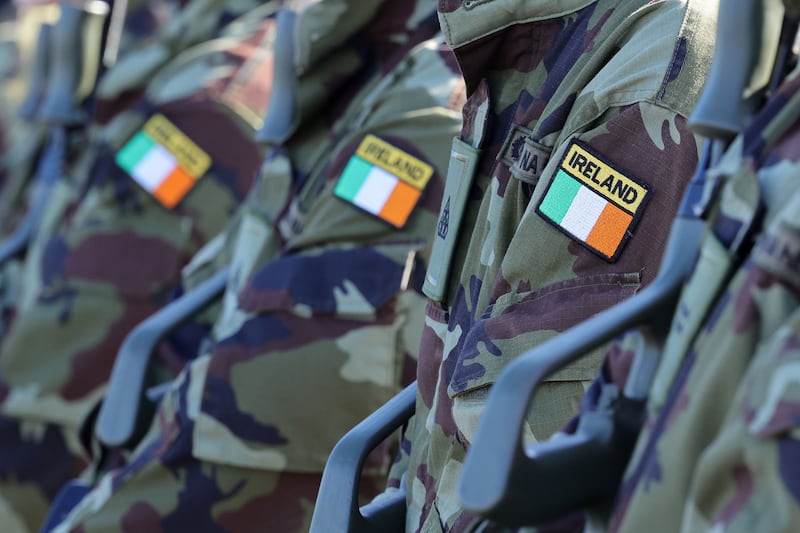Rachel Smith doesn’t remember her mother but her sister Lisa does, including the last words she ever said to her on that summer day in Dublin back in 1987. “She hugged us, told us ‘I’ll see you tomorrow, be good for your daddy and I’ll bring yous home a present tomorrow if you’re good’. She told us she loved us.”
But there was no “tomorrow” for the young mother of two Antoinette Smith. In the early hours of July 12th, after attending the David Bowie concert in Slane Castle, she was murdered. Her body was wrapped in plastic, with rope around her neck, and buried in a bog at Glendoo Mountain, off Military Rd, Co Wicklow.
Reports from the time, in The Irish Times, quote a Garda source saying it was suspected when Antoinette vanished she had “run off with another man”. Almost nine months after the 27-year-old from Clondalkin disappeared her remains were found by a family out walking.
[ Stolen Lives: 239 violent deaths of women in Ireland from 1996 to todayOpens in new window ]
Only then — on April 3rd, 1988 — did the case hit the newspapers and was the Garda investigation fully ramped up. The victim vanishing “did not cause much of a stir outside her own family” until her remains were found, according to reports at the time.
READ MORE
The Garda approach to the murder investigation, then and now, leaves a lot to be desired, the Smith women say. They have been told items related to the case found with their mother’s remains are no longer available for new DNA, and other, testing, as they were disposed of. More on that later.
Rachel and Lisa say they’ll never give up their hunt for justice, that they represent their mother now. They are “her only voice”. And they are both absolutely determined to find the answer to the question that dominated their childhoods and now their adult lives: “Who murdered our mam?”
Described by her daughters as “a real character”, Antoinette Smith loved live music; a passion now shared by both her daughters. The fact she married young and had two children while still in her early 20s did nothing to dampen her love of travelling to concerts. On July 11th, 1987, she went to Slane for the Bowie gig with a close woman friend.
While married to husband Karl for eight years at the time she vanished, the couple were estranged. On the morning of the concert, Antoinette took her daughters to meet their father on the Kylemore Road, where Lisa says she remembers her mother waving back at her as she walked away.
There were posters everywhere, on the buses; pictures of her handed out in the local shops even. But nothing came of it, that was the sad reality
Antoinette and her friend made their way to Slane where they enjoyed the concert together before returning to Dublin that evening by Dublin Bus. On arrival in Parnell Square in the city centre at about 11pm they went to the Harp Bar on O’Connell Bridge and later to La Mirage nightclub on nearby Parnell St.
They met two men in the nightclub and were seen speaking to them on O’Connell St, after La Mirage closed, just after 2am. There then appears to have been some dispute between the women; perhaps a disagreement about going home or continuing their night at a house party. They parted ways on O’Connell St and Antoinette began walking towards Westmoreland St.
At this juncture, with Antoinette now apparently alone, evidence from the time suggests she was next in the company of two other men and that all three got into a taxi close to Cleary’s department store.
The driver of that cab was traced by gardaí. He told detectives he brought Antoinette, and two men, to a location close to the Yellow House Pub in Rathfarnham, south Dublin. After that, the mother of two vanished until the following spring. On Easter Sunday, April 3rd, 1988, her remains were discovered by chance in her shallow grave.
[ Appeal over murder of Antoinette Smith on 35th anniversary of disappearanceOpens in new window ]
In the same month her body was found the Garda Investigation Unit, or murder squad, was disbanded as part of a reorganisation of resources by Garda Headquarters. Instead of a dedicated team of murder detectives investigating each case, responsibility fell to gardaí in the geographic areas where the killings occurred.
It was a controversial move at the time. It was seen as an unnecessary tampering with a specialist unit, that was catching killers, in favour of passing their expert role into general policing.
In 1988 some 22 murders were committed or discovered in the Republic, according to the Garda Commissioner’s report from the time. Just one of them — that of Antoinette Smith — went unsolved. The only killer who went undetected was the one whose crime was uncovered at precisely the moment the murder squad was being disbanded.
*************
Lisa says when her mother failed to show up at home by lunchtime the day after the concert — as per arrangement — she sensed her father “was getting worried”. When there was no sign of Antoinette through that day, concern began to grow across the extended family. Karl stayed once more overnight with Lisa and Rachel — aged 7 and 4 years at the time — in the home they usually shared with their mother.
The next day, worry and concern ramped up to alarm. Lisa says the true gravity of the situation was more or less lost on her initially. But when her mother’s brother arrived at their home it became clear something was going wrong for the family.
“He asked where my mam’s friend lived, the one she had gone to the concert with,” recalls Lisa. “So we went down there with him. He gave us a load of sweets and said ‘you stay there, don’t get out of the car’. And I remember thinking ‘uh oh, this is serious’.”
When Antoinette’s friend could not account for her, the family immediately reported her missing to the Garda.
Rachel says the family contacted her mother’s friends in Dublin and other parts of the country, including Limerick. But none of them had heard from Antoinette. The family also printed posters featuring the missing woman’s image, with an appeal for anyone who had seen her to come forward.
“They rang hospitals to see had she had an accident,” says Rachel of what she has been told of that time. “There were posters everywhere, on the buses; pictures of her handed out in the local shops even. But nothing came of it, that was the sad reality.”
Some 35 years on, Christmas and Mothers Day “are very hard” and the sisters think of all the missed milestones. Lisa remembers going with her mother to the zoo
The sisters say in the near nine-month period between their mother vanishing and her remains being found, the gardaí investigating the case appeared to become wrongly convinced their father was involved in her disappearance.
Rachel says the gardaí repeatedly asked her father to attend the local Garda station, often putting questions to him for many hours. She added on one occasion gardaí called to his place of work in the Semperit tyre factory in Ballyfermot, while his colleagues looked on, and asked him to accompany them to the station. “He’s very angry over the years about the way he was treated,” she said.
When the Garda Cold Case Unit — now the Serious Crime Review Team — was launched 15 years ago Rachel decided to contact it and asked that her mother’s murder be re-examined. While the team agreed — and the case has since been the subject of examination and Garda public appeals for information — she feels communication from the gardaí to the family should be clearer.
Rachel says the account of her mother’s last known movements is confusing. For example, she is still not sure if the two men her mother and her friend met in La Mirage were the same two men she is said to have taken a taxi with to Rathfarnham.
“This is where I get frustrated because it’s only in the last couple of years that we have found out that there wasn’t just two lads they met in the club,” she said. Furthermore, despite meeting many times with the cold case team, she has no idea if the two men who were supposed to be with her mother in Rathfarnham were ever traced. “Does anyone know anything about these two men? Did they actually go into the pub?
“The two men were seen acting suspiciously by the taxi driver; acting aggressively, trying not to pay the fare. So I’m saying to myself ‘has the taxi driver been re-interviewed’? And this is where we seem to be at — really at a standstill — for the last number of years. They’re reinterviewing people to see have their stories changed.”
Rachel is also frustrated that her mother’s friend — who she went to the David Bowie concert with and later on to La Mirage — has not been reinterviewed. Rachel said she has been told by gardaí while the woman was spoken to as part of the original investigation, she has not been spoken to so far by the cold case team. She believes that should be a priority, even if it may be very traumatic for her mother’s friend.
Rachel said that incrementally over the years the family has learned of more physical evidence found by gardaí and they wonder why they were not informed of it years ago.
“The bag that her body was found in; they disposed of that bag. And we only found out about this recently,” she said, adding gardaí told her the only DNA on it was her mother’s. But she believes it’s a missed opportunity to re-test, with the technology of the modern era, such an important piece of evidence.
“Her top was found, her David Bowie T-shirt. There was an earring found and jewellery. There’s a bag still missing, that she had her change of clothes in, as far as I know. But recently at a meeting with the gardaí a bag was mentioned. But there’s definitely also a bag missing — so we don’t know if that’s the bag with her clothes or ...”
She said the gardaí have explained there is a core of information they do not want emerging publicly as it might disclose to the killer details that could prove crucial if a firm suspect was ever nominated.
***************
Some 35 years on, they say Christmas and Mothers Day “are very hard” and they think of all the missed milestones. Lisa remembers going with her mother to the zoo — “a special place” — and an air show in Baldonnel. While she played soccer at youth level for Ireland, it was another missed “big thing” to share with her “mam”. She loves Michael Bublé and when she first saw him in concert she bumped into some of her mother’s friends in the crowd.
“And then I got upset. I was thinking ‘she should have been here, because her friends are here’. And they would have been her close circle, you know? That hurt me.”
Rachel says she’d “love to have memories” of her mother. But she was too young at the time and everything she knows about her has been passed on by family members or family friends. But that doesn’t diminish her enduring sense of loss. When she was a child she says she constantly felt her mother’s absence.
A woman goes out and never comes home to her children ... I mean, we were practically babies
“You’d have kids being kids, saying things like ‘where’s your mammy, you’re an orphan’. Then as you get older, you say to yourself ‘where is my mammy, why isn’t my mammy here?’ You question yourself: ‘why is my mammy not here?’”
Rachel said the thoughts of how her mother was killed and left buried in a remote bog are “quite sickening”. She has been told a young boy — aged 7 years and on a picnic with his family — spotted the remains by chance as her mother’s “finger was sticking up” from the bog drain where she was partially buried.
“We don’t know if she was sexually assaulted but she was strangled because the way her body was found ... she was found in a black bag with a rope tied around her neck. Apparently (the gardaí) still have the rope but the only DNA on it was my mam’s.” While Antoinette suffered with alopecia, her wig was never found.
Gardaí issued appeals in the case at the time, but only after Antoinette’s body was found — trying to stir the memories of witnesses from nine months earlier. They appealed for the men seen with her on O’Connell St to come forward, and the family believes they did so and were eliminated. But they are not certain of that; more information not made clear enough.
An identikit image of a man was circulated internally within the force in 1988, apparently of a man seen in the area of Killakee Woods, close to where Antoinette’s remains were found, in the hours she disappeared. It came to nothing.
Rachel ruminates on who might have killed her mother. For a time she fixated on Larry Murphy, the convicted rapist from Baltinglass in Co Wicklow, despite gardaí having ruled him out of their investigations. After trainee prison officer Patricia Doherty (29) disappeared in Tallaght, Dublin, in December 1991 her body was found the following June in the same bog as Antoinette Smith. Were the killings linked? Maybe carried out by the same person? The Smiths don’t know but it is another detail they mull and struggle with.
“It’s frustrating because there is no suspect,” says Rachel. “It could be someone we know. But we don’t know that because there’s no leads to even suggest someone might be a suspect.”
Lisa also says when her mother’s remains were found, by which time she had turned 8, she was informed of the discovery in a very insensitive manner and in the absence of any adults from her family. She said the Garda member who told them started by saying “I’ve good news and I’ve bad news”.
“’The good news is that we found your mammy and the bad news is that she’s dead’. Now, I’m 8 years old and I have concept of that word. I’m still scared from that. I’m 42 now and that stays with me.
“Everything was ripped from us and from that day that we knew she was murdered. The day she never came back, really, my life changed forever. I never thought I’d live my life not having her in it.”
But she’s still convinced the murder can be solved, adding people have information and can end the family’s pain of not knowing.
“A woman goes out and never comes home to her children ... I mean, we were practically babies. We’ve had a lifetime of hurt, a lifetime of asking why. We’re decent people and as long as I have a breath I will always fight for her. If it’s a confession on a deathbed, well ... But if that person was ever caught I would love to sit in a room and just ask them why? Like, why, why? What went through your head?”


















